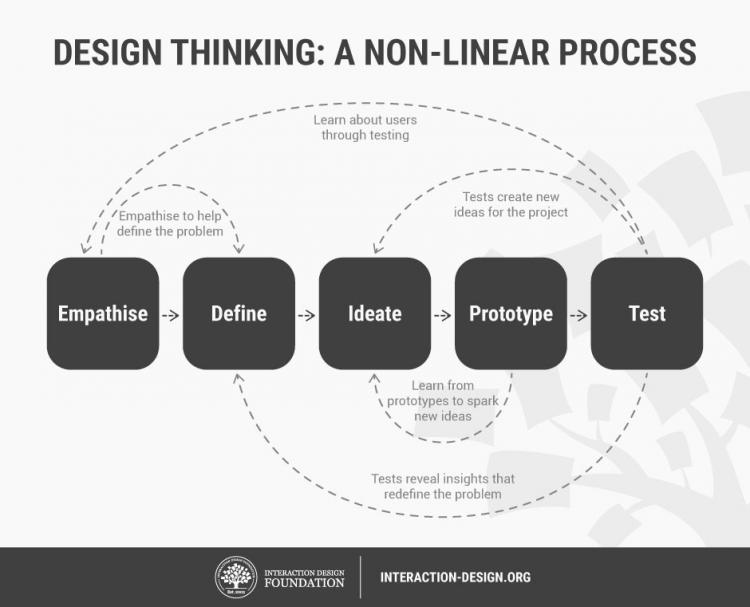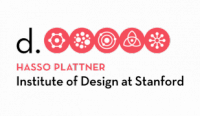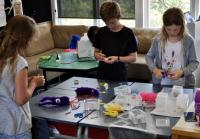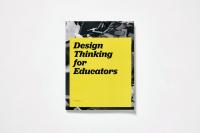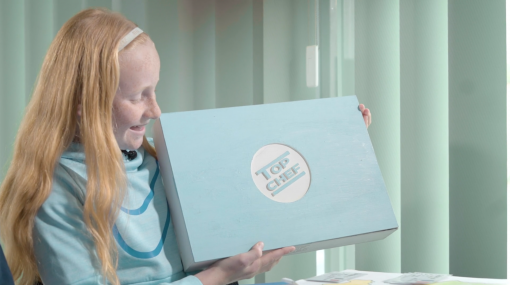Design thinking
How design thinking works
Design thinking is a methodology for creative problem solving
Design thinking is an iterative process that provides a solution-based approach to solving problems. Using a structured framework, students identify challenges, gather information, generate potential solutions, refine ideas, and test solutions.
A design thinking approach focuses on developing students’ creative confidence. Design thinking connects real world problem-solving with classroom environments. Teachers and students engage in hands-on design challenges that focus on:
- developing empathy
- promoting action
- encouraging ideation
- developing metacognitive awareness
- fostering active problem solving.
Throughout this iterative process students are encouraged to: understand the user, challenge assumptions, and redefine problems.
At the core of design thinking is the intention to improve products by analysing and understanding how users interact with products and investigating the conditions in which they operate. This involves asking questions and challenging assumptions. Once students have questioned and investigated the conditions of a problem, the solution-generation process will help produce ideas that reflect the genuine constraints and facets of that particular problem. Design thinking offers a way of digging deeper. It helps focus research, prototyping, and testing products and services to find new ways of improving the product, service or design.
The d.school's method of design thinking
There are a number of different models that fall under the umbrella of design thinking. The d.school at Stanford University model is frequently used. This model has five modes:
- Empathise: Learners observe, engage, watch, and listen. The purpose is to understand people, within the context of their design challenge. Who are they designing for and what is the problem that needs solving?
- Define: Learners explicitly define the challenge based on their new understanding of the people and the problem. They write a meaningful problem statement to guide their actions.
- Ideate: Learners generate ideas. Every idea is welcome. Judgement is suspended so that the team can move beyond obvious solutions and find innovative ideas to explore.
- Prototype: Students start building their solution for the end user. This is an iterative process that tolerates failure. Prototypes don't require too much commitment of time or resources.
- Test: Learners seek feedback on their prototypes from end-users. It's an opportunity to: gain empathy for and understanding of the people they are designing for, to refine prototypes, and solutions.
Iteration is key. The five modes are not always sequential. They do not have to follow any specific order and can often occur in parallel and repeat iteratively. Learners cycle through the process any number of times to arrive at a workable end solution.
Key resource
Get started with design thinking
The Standford d.school's introduction to their model of design thinking.
Design thinking stands alongside other constructivist approaches such as inquiry-based learning, computational thinking, STEAM, makerspaces, and project-based learning. Design thinking empowers students to change their social and environmental contexts through design.
The impact of design thinking on student learning
Steve Mouldey, CORE Education eFellow and Hobsonville Point Secondary teacher, discusses his research into the impact of Design Thinking on student learning.
Design thinking helps students to:
- develop an innovator's mindset
- connect what they learn in class to real world challenges
- foster a disposition of problem-solving
- collaborate and work with others
- build empathy by thinking about the needs of other people, of others as the "end users" of their creative solutions
- feel empowered to make meaningful changes to the world around them
- foster the kind of creativity and solutions-driven thinking required in 21st century workplaces.
Design thinking in Hangarau and Technology
Design thinking is a key learning approach in the Technology and Hangarau curricula. This is because Hangarau is a human-centred and process-driven learning area. Hangarau is intervention by design – it works to address human needs by creating specifically for the end-user. The design thinking approach guides students through this process of design.
"With its focus on design thinking, technology education supports students to be innovative, reflective and critical in designing new models, products, software, systems and tools that will benefit people, while expressing empathy for the cultural, ethical, environmental, political, and economic conditions of the day."
– Technology in the New Zealand Curriculum , Ministry of Education, 2017
Te Tukanga Hoahoa Whakaaro - A Māori Design Thinking Framework
Inspired by the late Cliff Whiting's design process as shared in Ian Christensen's book He Toi Nuku, He Toi Rangi, the Kia Takatū ā-Matihiko team created Te Tukanga Hoahoa Whakaaro – a design thinking process derived from Te Ao Māori. Watch the video below to first explore the whakapapa (origins) and nature of the process.
Design thinking for professional learning
Design thinking is increasingly being used as a tool for activating change at a leadership level. Staff are using it to create new learning programmes, re-design learning spaces, or find the right tools for collaborating.
Teachers can introduce design thinking to help learners frame challenges across curriculum areas, including those not normally associated with technology or design, such as social studies, English, and maths.
When applied to classroom learning, design thinking can:
- turn traditional academics into creative, hands-on projects
- apply process-driven frameworks to STEAM challenges and makerspace projects
- give students a tool for driving community action and social entrepreneurship projects beyond the classroom.
Design thinking across learning areas
Rāroa Intermediate Normal School teacher, Chris Johnston used the context of game design for a student inquiry. He outlines the notosh design thinking model he used with his students. Chris explains, "the immersion part is really important because it exposes kids to new ideas. It meant playing board games and starting to develop our critical thinking skills and our language about how we talked about them." During this phase, local game designers came into the classroom to share their expertise. Students went right through the design process from concept to building a finished game. Student, Charlie commented, "My favourite bit was probably getting to play the game and have a finished product. It was quite nice to get better at saying, Well I really want to do this. It's not going to work, so I'll just have to leave it at that." Through the inquiry students developed understandings of geometry, measurement, probability, English, and technology.
International examples of teachers using design thinking
These stories from teachers around the world provide examples of inspiring design thinking projects in classroom contexts.
Design thinking can work in any subject
John Spencer discusses how design thinking can turn any traditional learning content into a hands-on project.
How might we the content?: Applying design thinking in a high school English classroom
English teacher Dan Ryder discusses how reading can become an act of problem-solving when applied through the lens of deep design thinking.
Learning is open: Design thinking toolkit
Explanations and project examples of design thinking in an educational context
Jump start projects
This 12-week Jump Start program in Australia sees school students apply design thinking to a problem affecting current and future living standards.
Getting started with a design challenge
These resources help teachers begin using design thinking in the classroom by implementing design challenges.
d.school Starter Kit
This online starter kit from Stanford's d.school introduces a medley of design methods and mindsets.
Library of Ambiguity
In this digital library, you’ll discover resources that come from both outside and inside Stanford's d.school
Tools for design thinking
Colloboration is an essential component of design thinking projects. As teams of learners empathise, define, and ideate together, using digital collaboration tools makes sharing ideas and prototyping more streamlined and engaging.
Mural
A cloud-based, visual collaboration tool. Mural is a virtual canvas of post-it notes, images, and ideas.
Google Keep
A collaborative note-taking tool that works with Google accounts.
TimeTimer
A classroom tool for presenting a visual representation of time elapsed. This is particularly useful when doing timed design challenges.
Sketch up
Free 3D digital design tool. Ideal for prototyping and mocking up design solutions.
Sorry, no items found.
Key resources
The d.school at Stanford University
Get started with design thinking
The Standford d.school's introduction to their model of design thinking.
IDEO's design thinking for educators toolkit
Have a look around IDEO's website. It contains resources contain examples, school stories, and toolkits for teachers ready to bring design thinking into the classroom.
Web links
Design thinking: Department of the Prime Minister and Cabinet
Written for the New Zealand government, this page is a good general explanation of the advantages of design thinking
Learning is open: Design thinking toolkit
Explanations and project examples of design thinking in an educational context
Jump start projects
This 12 week Jump Start program in Australia sees school students apply design thinking to a problem affecting current and future living standards.
Blog posts
Design thinking can work in any subject
John Spencer discusses how design thinking can turn any traditional learning content into a hands-on project.
How might we the content?: Applying design thinking in a high school English classroom
English teacher Dan Ryder discusses how reading can become an act of problem-solving when applied through the lens of deep design thinking.
Research
Design Thinking in Pedagogy – Luka, Ineta (2014). Design Thinking in Pedagogy. Journal of Education Culture and Society, No. 2, 63-74.
Tools supporting the design thinking process
Mural
A cloud-based, visual collaboration tool. Mural is a virtual canvas of post-it notes, images, and ideas.
Google Keep
A collaborative note-taking tool that works with Google accounts.
TimeTimer
A classroom tool for presenting a visual representation of time elapsed. This is particularly useful when doing timed design challenges.
Sketch up
Free 3D digital design tool. Ideal for prototyping and mocking up design solutions.
